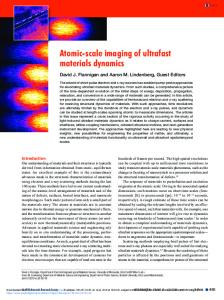Materials at Atomic Scale
This chapter presents the materials that are used in electronics at atomic scale. It starts with atomically thin materials, which are monoatomic layers, also known as atomically thick materials or 2D materials. These include the most widespread 2D materia
- PDF / 10,479,550 Bytes
- 227 Pages / 453.543 x 683.15 pts Page_size
- 3 Downloads / 332 Views
Atomic-Scale Electronics Beyond CMOS
Atomic-Scale Electronics Beyond CMOS
Mircea Dragoman Daniela Dragoman •
Atomic-Scale Electronics Beyond CMOS
123
Mircea Dragoman National Research and Development Institute in Microtechnology Voluntari, Romania
Daniela Dragoman Faculty of Physics University of Bucharest Magurele, Romania
ISBN 978-3-030-60562-9 ISBN 978-3-030-60563-6 https://doi.org/10.1007/978-3-030-60563-6
(eBook)
© Springer Nature Switzerland AG 2021 This work is subject to copyright. All rights are reserved by the Publisher, whether the whole or part of the material is concerned, specifically the rights of translation, reprinting, reuse of illustrations, recitation, broadcasting, reproduction on microfilms or in any other physical way, and transmission or information storage and retrieval, electronic adaptation, computer software, or by similar or dissimilar methodology now known or hereafter developed. The use of general descriptive names, registered names, trademarks, service marks, etc. in this publication does not imply, even in the absence of a specific statement, that such names are exempt from the relevant protective laws and regulations and therefore free for general use. The publisher, the authors and the editors are safe to assume that the advice and information in this book are believed to be true and accurate at the date of publication. Neither the publisher nor the authors or the editors give a warranty, expressed or implied, with respect to the material contained herein or for any errors or omissions that may have been made. The publisher remains neutral with regard to jurisdictional claims in published maps and institutional affiliations. This Springer imprint is published by the registered company Springer Nature Switzerland AG The registered company address is: Gewerbestrasse 11, 6330 Cham, Switzerland
Preface
The fact that the number of transistors on very large-scale integrated (VLSI) circuits, including microprocessors, is doubling every two years, a prediction known as Moore’s law is already a history. This prediction was valid for almost fifty years, but its predicted rhythmicity was lost when the dimensions of the transistors started to be lower than 14 nm. The reduction of transistor dimensions below 5 nm will be very difficult to handle, especially due to the high economic costs to produce equipments to produce VLSI circuits containing each billions of transistors at the level of mass production. Thus, increasing computing performances based on increasing the number of transistors in a chip will be no longer possible as soon as transistors reach the atomic scale. These simple facts inspired a large number of papers and predictions about the “catastrophes” accompanying the end of Moore’s law. There are concerns that many industries based on computation will suffer, since the transistors have reached the atomic scale. What will follow when Moore’s law is ended? Are the atomic-scale devices a barrier for further development of electronics? These basic questions are the subject of
Data Loading...










